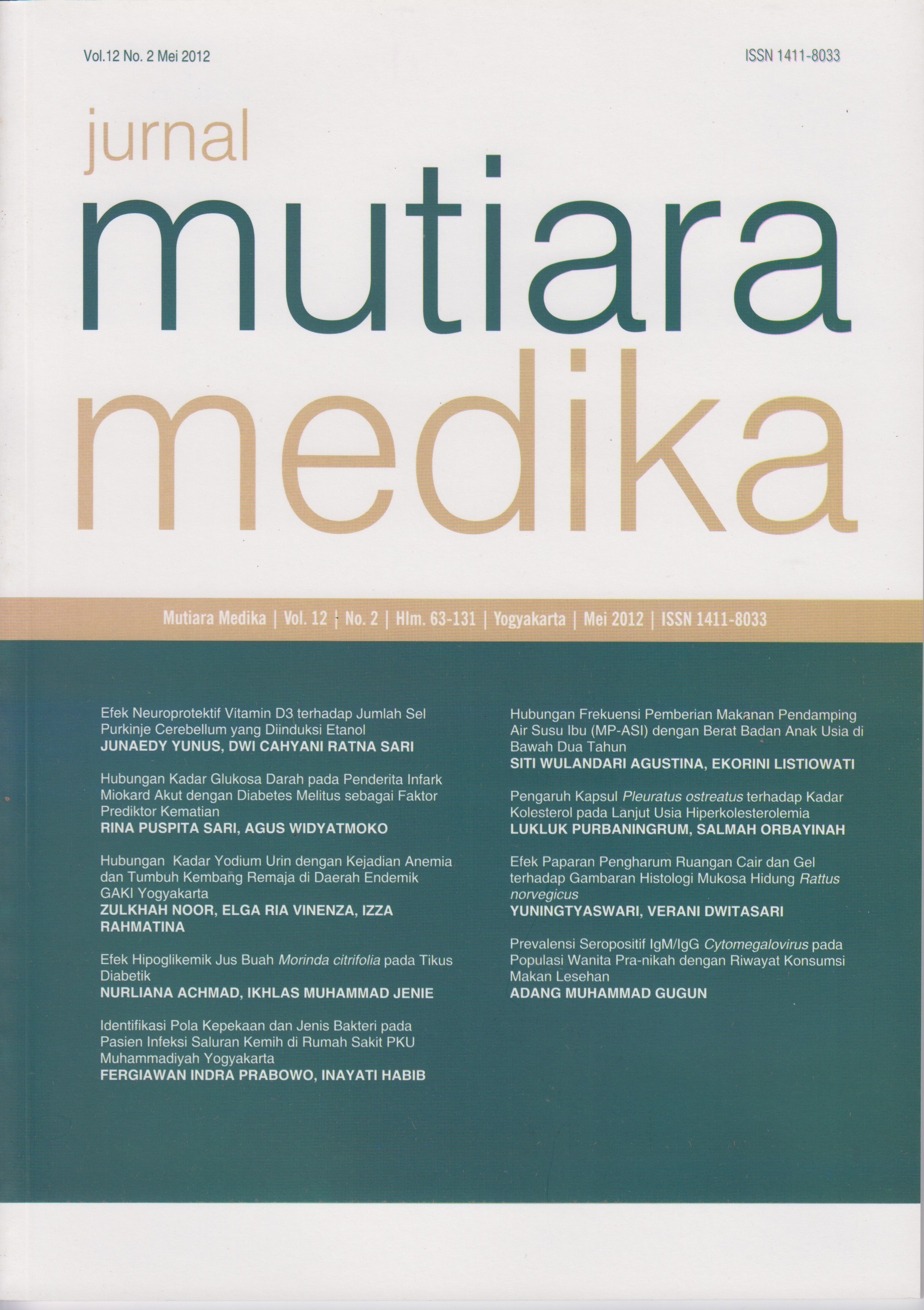Efek Pemberian N-Acetylcysteine Oral terhadap Kadar hsCRP Serum pada Continuous Ambulatory Peritoneal Dialysis
DOI:
https://doi.org/10.18196/mmjkk.v11i2.936Keywords:
Continuous Ambulatory Peritoneal Dialysis (CAPD), high-sensitivity C-reactive protein (hsCRP), N-asetilsistein (NAS), chronic kidney disease (CKD)Abstract
Inflamasi dan stres oksidatif merupakan faktor risiko kardiovaskuler pada pasien chronic kidney disease (CKD).N-asetilsistein (NAS) mengandung thiol sebagai antioksidan yang memiliki aktivitas antiinflamasi dan memperlihatkan penurunan angka kejadian kardiovaskuler pada pasien hemodialisis. Penelitian ini bertujuan menentukan efek NAS oral (2 x 600 mg/hari) terhadap kadar petanda inflamasi pada pasien Continuous Ambulatory Peritoneal Dialysis (CAPD). Perlakuan diberikan selama 8 minggu pada 32 pasien (80% laki-laki, usia 42±7 tahun) yang menjalani regular CAPD. Sebelum perlakuan pasien dibagi menjadi dua kelompok masing-masing 16 pasien.Sitokin proinflamasi (high-sensitivity Creactive protein/hsCRP) diukur sebelum dan sesudah perlakuan dengan NAS. Hasil penelitian menunjukkan bahwa pemberian NAS, secara bermakna menurunkan kadar hsCRP (-1,50±1,32 vs 0,56±1,25 pg/mL, p<0,001) dibandingkan kelompok kontrol. Disimpulkan bahwa pemberian NAS peroral mampu menurunkan kadar hsCRP pasien CAPD.
References
Van Biesen W, De Bacquer D, Verbeke F, Delanghe J, Lameire N, Vanholder R. The glomerular filtration rate in an apparently healthy population and its relation with cardiovascular mortality during 10 years. Eur Heart J. 2007;28: 478–483 ;
Vanholder R, Massy Z, Argiles A, Spasovski G, Verbeke F, Lameire N. Chronic kidney disease as cause of cardiovascular morbidity and mortality. Nephrol Dial Transplant. 2005 ; 20:1048–56.
Stenvinkel P, Carrero JJ, Axelsson J, Lindholm B, Heimburger O, Massy Z. Emerging biomarkers for evaluating cardiovascular risk in the chronic kidney disease patient: How do new pieces fit into the uremic puzzle? Clin J Am Soc Nephrol. 2008;3:505–21.
Zachwieja J, Zaniew M, Bobkowski W, Stefaniak E, Warzywoda A, Ostalska-Nowicka D, et al. Beneficial in vitro effect of N-acetylcysteine on oxidative stress and apoptosis. Pediatr Nephrol. 2005;20:725–31.
Jourde-Chiche N, Dou L, Cerini C, DignatGeorge F, Brunet P. Vascular incompetence in dialysis patients—protein-bound uremic toxins and endothelial dysfunction. Semin Dial. 2011;24(3):327-37
Nolan C. Strategies for Improving Long-Term Survival in Patients with ESRD.J Am Soc Nephrol. 2005;16:S120–S127.
Clendenen TV, Koenig KL, Arslan AA, Lukanova A, Berrino F, Gu Y et al. Factors associated with inflammation markers, a crosssectional analysis. Cytokine. 2011 Dec; 56(3): 769-78
Witko-Sarsat V, Gausson V, Nguyen AT, Touam M, Drueke T, Santangelo F, et al. AOPP-induced activation of human neutrophil and monocyte oxidative metabolism: a potential target for N-acetylcysteine treatment in dialysis patients. Kidney Int. 2003;64:82–91
Priya S, Vijayalakshmi P, Vivekanandan P, Karthikeyan S. Influence of N-acetylcysteine against dimethylnitrosamine induced hepatotoxicity in rats. Toxicol Ind Health. 2011 Nov; 27:914-922.
Tepel M. N-Acetylcysteine in the prevention of ototoxicity.Kidney Int. 2007;72:231–2.
Jourde-Chiche N, Dou L, Cerini C, DignatGeorge F, Brunet P. Vascular incompetence in dialysis patients—protein-bound uremic toxins and endothelial dysfunction. Semin Dial. 2011;24(3):327-37.
Brunet P, Gondouin B, Duval-Sabatier A, Dou L, Cerini C, Dignat-George F, Jourde-Chiche N, Argiles A, Burtey S. Does uremia cause vascular dysfunction? Kidney Blood Press Res 2011;34(4):284-90
Ramirez R, Martin-Malo A, Aljama P. Inflammation and hemodiafiltration. Contrib Nephrol 2007;158:210-5.
Schepers E, Barreto DV, Liabeuf S, Glorieux G, Eloot S, Barreto FC, et al.Symmetric Dimethylarginine as a Proinflammatory Agent in Chronic Kidney Disease. Clin J Am Soc Nephrol. 2011;6: 2374–83
Cuzzocrea S, Mazzon E, Costantino G, SerrainoI, De Sarro A, Caputi AP. Effects of nacetylcysteine in a rat model of ischemia and reperfusion injury. Cardiovasc Res. 2000 ; 47(3):537-548.
Hayakawa H, Ishibashi T, Sekiguchi M. A novel mechanism for preventing mutations caused by oxidation of guanine nucleotides. EMBO. 2003; 4(5): 479-83.
Nascimento MM, Suliman ME, Silva M, Chinaglia T, Marchioro J, Hayashi SY, et al. Effect of oral n-acetylcysteine treatment on plasma inflammatory and oxidative stress markers in peritoneal dialysis Patients: a placebo-controlled study. Perit Dial Int. 2010; 30:336-42.
Tepel M, van der Giet M, Statz M, Jankowski J, Zidek W. The antioxidant acetylcysteine reduces cardiovascular events in patients with end-stage renal failure: a randomized, controlled trial. Circulation. 2003;107:992–5.
Zachwieja J, Zaniew M, Bobkowski W, Stefaniak E, Warzywoda A, Ostalska-Nowicka D, et al. Beneficial in vitro effect of N-acetylcysteine on oxidative stress and apoptosis. Pediatr Nephrol. 2005;20:725–31.
Bridgeman MM, Marsden M, MacNee W, Flenley DC, Ryle AP. Cysteine and glutathione concentrations in plasma and bronchoalveolar lavage fluid after treatment with N-acetylcysteine. Thorax. 1991;46:39–42
Thaha M, Widodo, Pranawa W, Yogiantoro M, Tomino Y. Intravenous N-acetylcysteine during hemodialysis reduces asymmetric dimethylarginine level in end-stage renal disease patients. Clin Nephrol. 2008;69:24–32.
Glorieux G, Vanholder R. New uremic toxins which solutes should be removed? Contrib Nephrol. 2011;168:117-28
Downloads
Published
Issue
Section
License
Copyright
Authors retain copyright and grant Mutiara Medika: Jurnal Kedokteran dan Kesehatan (MMJKK) the right of first publication with the work simultaneously licensed under an Attribution 4.0 International (CC BY 4.0) that allows others to remix, adapt and build upon the work with an acknowledgment of the work's authorship and of the initial publication in Mutiara Medika: Jurnal Kedokteran dan Kesehatan (MMJKK).
Authors are permitted to copy and redistribute the journal's published version of the work (e.g., post it to an institutional repository or publish it in a book), with an acknowledgment of its initial publication in Mutiara Medika: Jurnal Kedokteran dan Kesehatan (MMJKK).
License
Articles published in the Mutiara Medika: Jurnal Kedokteran dan Kesehatan (MMJKK) are licensed under an Attribution 4.0 International (CC BY 4.0) license. You are free to:
- Share — copy and redistribute the material in any medium or format.
- Adapt — remix, transform, and build upon the material for any purpose, even commercially.
This license is acceptable for Free Cultural Works. The licensor cannot revoke these freedoms as long as you follow the license terms. Under the following terms:
Attribution — You must give appropriate credit, provide a link to the license, and indicate if changes were made. You may do so in any reasonable manner, but not in any way that suggests the licensor endorses you or your use.
- No additional restrictions — You may not apply legal terms or technological measures that legally restrict others from doing anything the license permits.






